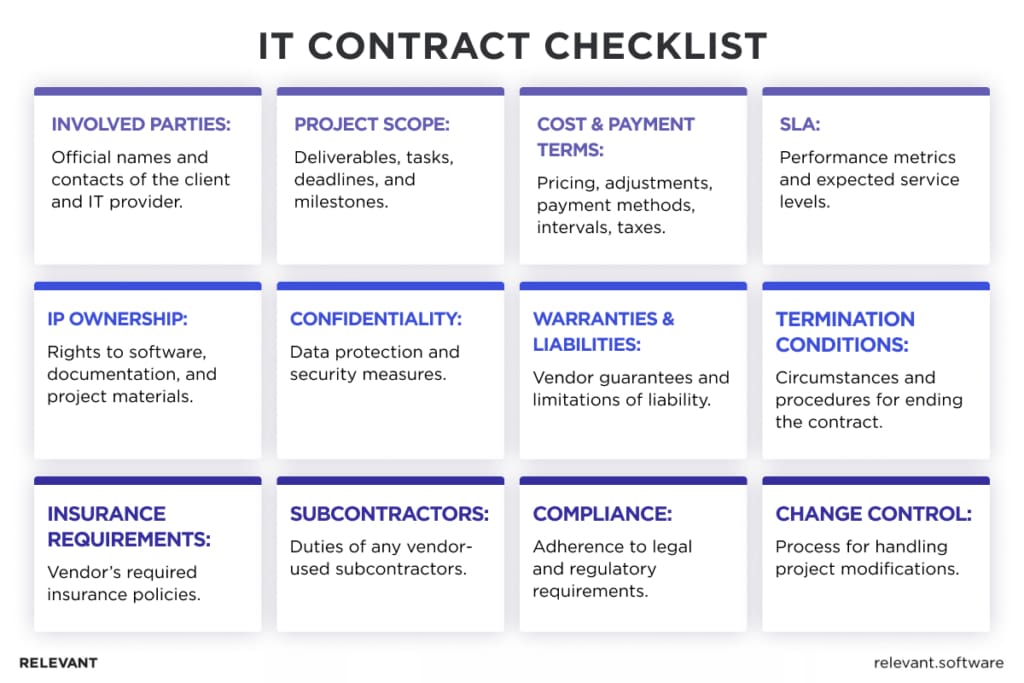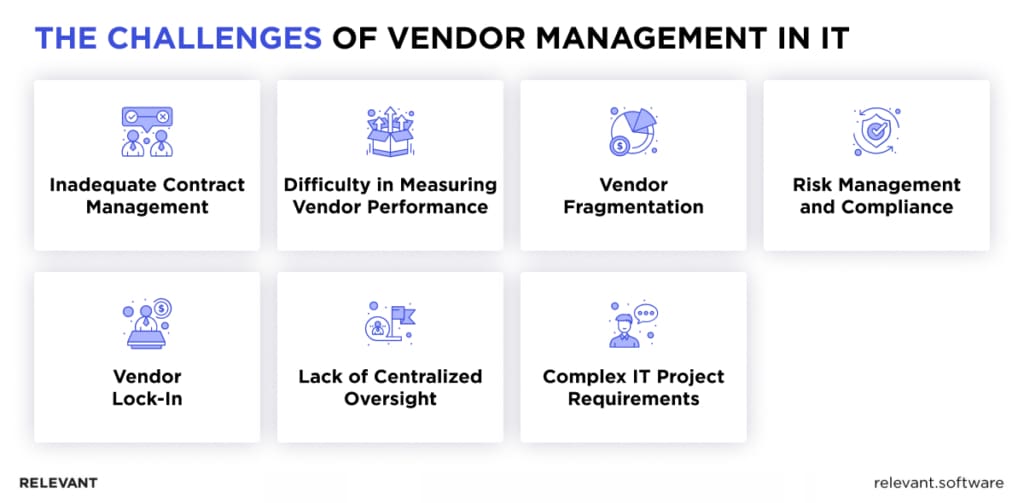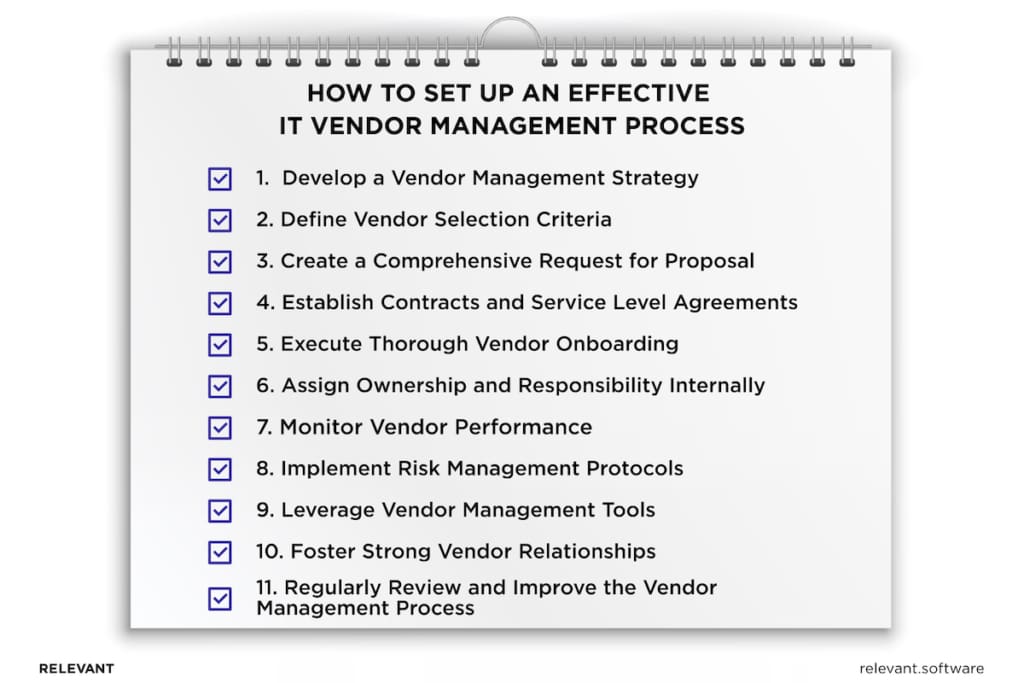Master IT Vendor Management: 11 Proven Strategies to Get It Right
Updated: October 21, 2024
In today’s outsourcing-focused market, businesses rely heavily on IT service providers for specialized software product development services, with the average organization partnering with 11 external vendors. A vast vendor ecosystem offers significant benefits—access to specialized expertise, increased operational capacity, greater efficiency, and cost savings. However, managing such a large and diverse vendor base comes with its challenges. Without a structured IT vendor management approach, businesses risk inefficiencies, missed innovation opportunities, and heightened security and compliance vulnerabilities.
Need to fine-tune your vendor relationships? Check out our full article, where we cover the top strategies for mastering IT vendor management—designed to help your business streamline processes, mitigate risks, and drive long-term success.

We provide companies with senior tech talent and product development expertise to build world-class software. Let's talk about how we can help you.
Contact usTable of Contents
What is Vendor Management?
As described in the vendor management definition, it is a structured process that organizes, optimizes, and coordinates collaboration with third-party providers to maximize value. This approach helps maintain smooth operations and improves communication while ensuring consistent knowledge transfer and quick responses to issues. Additionally, it promotes transparency and gives you greater control over the contract terms, quality, and delivery of services in the long run.
Why Vendor Relationships Are Critical
While vendor relationships may appear seamless on the surface, inefficiencies, poor performance, or compliance risks can lurk beneath. Vendors may fail to meet expectations without proper oversight, which leads to a lack of visibility, overpayments for poor-quality solutions, security vulnerabilities, or slow technology adoption. Long-term vendor contracts can also lock companies into outdated technologies that limit their ability to innovate.
Risks of Ineffective Vendor Management
- Operational disruptions and financial impact.
- Overpayment for underperforming solutions.
- Exposure to data breaches and legal non-compliance.
- Inability to adopt innovative technologies due to inflexible vendor contracts.
- Loss of control over critical systems and services.
The Essential Components of IT Vendor Management
In today’s competitive and technology-driven landscape, an effective IT vendor management system is more than a cost-saving mechanism—it is a strategic process that ensures your vendors contribute to your organization’s innovation and long-term success. A well-executed vendor management strategy enables businesses to align external partnerships with internal goals, improve operational efficiency, and mitigate risks.
Let’s explore the five essential components of IT vendor management.
1. Vendor Selection and Evaluation
Vendor selection is the foundation of a successful IT vendor management lifecycle. This first step is essential to define the service scope and decide how many vendors to engage. While managing fewer vendors might simplify the process, delegating specific areas to specialized vendors is often necessary for objective reasons.
Steps for IT vendor selection:
- Identify the project scope and required skills.
- Research companies with experience in similar projects.
- Contact selected vendors for availability and quotes.
- Compare vendors based on technologies, methodologies, and reviews.
- Conduct discovery calls to discuss project details.
- Start working with the best-fit IT vendor!
We’ve shortened the vendor selection process section here since it has already been thoroughly explored in our previous article (linked above).
2. Contract and SLA Management
A well-defined contract is the backbone of any business partnership. Contract and SLA (Service Level Agreement) management ensures the terms of cooperation are clear, minimizing risks and avoiding unexpected costs.

3. Performance Management
Performance management is essential to ensure your vendor delivers satisfactory results that are aligned with the agreed terms of its IT outsourcing services. This responsibility usually lies with a Project Manager or Product Owner, who verifies the vendor’s performance. The cornerstone of performance management is tracking Key Performance Indicators (KPIs)—these metrics help you evaluate various aspects of the project, such as cycle time, page load speeds, scalability under heavy traffic, and server performance. Performance management also involves monitoring costs and overall profitability to ensure that the partnership delivers value.
4. Relationship Management
Vendor management isn’t just about numbers and contracts—strong relationships play a key role in successful partnerships. From the very start of a project, both the client and vendor should see themselves as partners who work toward a shared goal.
Maintaining open communication and transparency is vital. Vendors should feel comfortable discussing both wins and challenges so you can work together to find the best solutions. Feedback, especially constructive criticism, is just as important as praise. Regular recognition like a simple “Great job, team!” can go a long way in boosting morale and keeping the collaboration energized. Defining quantifiable goals and weekly updates, along with a shared communication channel, will ensure a smooth flow of information and foster trust with their business partners.
5. Risk Management
With 98% of organizations worldwide working with at least one vendor that has experienced a data breach and 59% of companies encountering data leaks through third-party suppliers, risk management is more crucial than ever.
Data security breaches are a real and serious threat, so it’s essential to plan for the worst-case scenario. IT vendor risk management involves crafting and implementing strategies for when something goes wrong. In collaboration with your vendor, it’s crucial to create a “What if…” plan that clearly outlines the steps to follow during a security breach or other critical event and designates responsibility for each specific action.
Advantages of a Well-Structured Vendor Management Process
A comprehensive vendor management strategy offers far-reaching benefits beyond mere cost control or contract administration. Here are its core benefits:
- Improved Vendor Selection. A structured SaaS vendor management process ensures that vendors are chosen based on alignment with your broader business objectives, not just short-term project requirements. This leads to stronger, more strategic partnerships and consistent results.
- Enhanced Cost Efficiency. A robust vendor management process ensures that businesses negotiate favorable contracts and control spending more effectively. Long-term partnerships often lead to better pricing and fewer unforeseen costs due to clear expectations and optimized agreements.
- Higher Quality of Service. An organized vendor management framework enables constant performance evaluation. Monitoring vendors against set performance indicators (KPIs and SLAs) ensures higher customer service quality and allows you to address issues proactively.
- Reduced Risk Exposure. A strong framework incorporates risk identification and mitigation strategies to minimize exposure to operational disruptions, regulatory penalties, or security breaches. Early identification of risks during vendor onboarding or contract negotiations significantly reduces the chances of critical failures.
- Stronger Vendor Relationships. Moving beyond transactional relationships, thoughtful SaaS vendor management fosters true collaboration. Vendors who feel valued are more likely to bring innovative solutions, elevate service levels, and prioritize your business over competitors.
- Better Performance Visibility. With a clear management process, businesses gain full visibility into vendor performance, contract adherence, and service delivery. This oversight enables better decision-making and ensures that vendors meet expectations consistently.
- Scalability and Flexibility. A well-executed agile vendor management strategy allows organizations to scale operations efficiently and adapt vendor partnerships to evolving business demands, ensuring that expansion or shifts in strategy occur seamlessly and without disruption.
IT Vendor Procurement vs. Strategic IT Vendor Management: What are Key Differences?
While both IT vendor procurement and strategic IT vendor management are essential components of working with third-party vendors, they serve distinct roles within an organization’s IT strategy.
The main distinction lies in the methodology: procurement focuses on vendor selection primarily based on cost. In turn, strategic vendor management prioritizes maximizing value by creating a collaborative, flexible, and long-term vendor network that aligns with broader business objectives.
Strategic and agile vendor management is essential for addressing challenges related to the IT industry—where multi-year outsourcing agreements are the norm. Yet, the failure rate of IT outsourcing remains high. Below, we’ll explain why.
The Challenges of Vendor Management in IT
While many companies engage in software development outsourcing, a surprising number do not have formal IT vendor management strategies. According to research from ISG, 92% of Forbes Global 2000 companies outsource their IT services, yet only a minority have developed structured vendor management frameworks.
A well-defined IT vendor management plan helps businesses select the right vendors by focusing on critical factors like cost-effectiveness, security, compliance, and feature alignment. However, even with a strategy, companies may face significant challenges in managing remote development teams. Here are the key to them:

Inadequate Contract Management
Many IT contracts fail to account for the fast-paced nature of technological advancements or shifts in project requirements. Rigid contracts that focus too heavily on cost savings can lock companies into outdated technologies or services that no longer meet their needs. Contractual inflexibility can hinder agility and responsiveness to market changes.
Difficulty in Measuring Vendor Performance
Evaluating vendor performance in IT can be difficult due to the highly technical nature of services. Defining suitable KPIs and SLAs proves crucial but is often a challenge. Metrics like code quality, system uptime, and response times are hard to measure consistently, making it difficult to hold vendors fully accountable for their performance and outcomes.
Vendor Fragmentation
Large IT projects often require multiple vendors, each responsible for specific areas like software development, cloud infrastructure, or cybersecurity. Managing a fragmented vendor ecosystem creates challenges in coordination, communication, and consistency across the board. Without a cohesive management approach, this fragmented structure may cause miscommunication, inefficiencies, and project delays.
Risk Management and Compliance
IT vendor management involves substantial risks, especially around data security, privacy laws, and regulatory compliance. Third-party vendors may introduce vulnerabilities that expose your organization to data security issues, data breaches, non-compliance with regulatory requirements, or intellectual property theft.
Vendor Lock-In
Overdependence on a single vendor for critical services can lead to vendor lock-in, where any transition to another provider becomes difficult and costly due to proprietary technologies or restrictive contracts. This dependence limits flexibility and bargaining power, which may negatively affect service quality or hinder innovation.
Lack of Centralized Oversight
In large organizations, vendor management may be spread across different departments, which leads to a lack of centralized control. This decentralization can result in inconsistent vendor policies, fragmented communication, and missed opportunities for vendor relationship optimization. Without clear ownership, vendor management efforts may become disjointed.
Complex IT Project Requirements
IT projects often come with complex requirements that need specialized vendor expertise. It’s essential for vendors to grasp and execute these needs accurately, which can be difficult due to technical intricacies or shifting project scopes. Misalignment between a vendor’s skills and project requirements can cause setbacks, delays, or even project failure if not properly managed and aligned.
Related – Guide to Writing a Software Requirements Specification
How to Set Up an Effective IT Vendor Management Process
Addressing IT vendor management complexities requires more than ad-hoc solutions. Here’s a detailed guide to setting up a successful vendor management strategy:

1. Develop a Vendor Management Strategy
Start by aligning your vendor management process with your overall business objectives. Define key goals for vendor relationships, whether they involve cost reduction, innovation, service quality, or scalability. A clear strategy will guide your vendor selection and management practices.
2. Define Vendor Selection Criteria
Identify the required skills, competencies, and experience levels your IT vendors must possess. To ensure the right fit:
- Specify the services or products required based on an in-depth analysis of your business needs.
- Evaluate candidates based on technical expertise, performance history, robust security protocols, and adherence to industry regulations.
- Prioritize vendors whose capabilities align with your long-term business objectives rather than simply choosing the lowest-cost option.
3. Create a Comprehensive Request for Proposal
A well-crafted Request for Proposal (RPF) is essential to attract the right vendors. The RFP should:
- Clearly state your project scope, technical requirements, timelines, and budget.
- Include specific RFI questions (Request for Information) that assess the vendor’s capabilities, methodologies, security protocols, and compliance measures.
- Request case studies or examples of previous work to ensure the vendor’s experience aligns with your needs.
4. Establish Contracts and Service Level Agreements
Once the vendor is selected, clearly define contractual terms that cover performance expectations, service-level agreements (SLAs), penalties for non-compliance, and confidentiality. Flexibility in contracts is vital to adapt to future changes, such as scaling operations or incorporating new technology.
Contracts should cover:
- Scope of work, deliverables, timelines, and pricing.
- SLAs that outline performance expectations, such as uptime, response times, and quality metrics.
- Intellectual property rights, confidentiality clauses, and data security obligations.
- Termination clauses and procedures for dispute resolution.
Related – The Ultimate Guide to Understanding Software Master Service Agreement
5. Execute Thorough Vendor Onboarding
Onboarding, though often overlooked, is key for productive vendor relationships. A strong approach should include:
- Detailed transfer of technical knowledge about your company’s IT goals, systems, and workflows.
- Clear communication channels, escalation procedures, and reporting frameworks for seamless collaboration between internal engineering teams and external vendors.
- Introducing vendors to key stakeholders which ensures everyone understands their responsibilities, from project managers to infrastructure leads.
6. Assign Ownership and Responsibility Internally
Ensure that your internal team has defined roles for managing the vendor relationship. This includes:
- Assigning a dedicated project manager or vendor management lead who will serve as the primary point of contact for vendors.
- Explicitly detailing responsibilities for contract management, payment processing, and performance evaluation.
- Proper internal ownership prevents confusion and ensures efficient vendor oversight.
7. Monitor Vendor Performance
To effectively track vendor performance against SLAs, follow these steps:
- Regularly assess vendor data, focusing on key metrics like uptime, service quality, and response times.
- Use KPIs that align with the specific services your vendors offer for periodic evaluations.
- Schedule consistent check-ins or performance reviews to address any concerns, refine strategies, and ensure vendors meet the expected standards.
8. Implement Risk Management Protocols
Vendor relationships come with inherent risks—ranging from operational disruptions to compliance issues and data breaches. A thorough risk assessment and mitigation plan should be integrated into the vendor management process from the outset.
- Conduct thorough due diligence via vendor selection to identify potential risks (security, compliance, operational reliability).
- Implement contingency plans to manage potential disruptions or service failures.
- Regularly update risk management protocols to reflect regulatory landscapes, especially in areas such as data privacy (GDPR, HIPAA).
9. Leverage Vendor Management Tools
Utilize software tools to streamline and automate aspects of the vendor management process. These tools can help with:
- Centralization of vendor information and contracts for easy access.
- Automation of performance reviews and compliance audits.
- Management of invoicing, payments, and approval workflows.
- Enhanced visibility into the vendor ecosystem for improved decision-making.
Vendor management software like Kissflow, Precoro, and Jira can significantly improve the efficiency of vendor management processes.
10. Foster Strong Vendor Relationships
Building strong partnerships with vendors goes beyond contracts and KPIs. To really nurture these relationships, it’s crucial to:
- Foster open communication and give consistent feedback to build trust and encourage teamwork.
- Invest in long-term partnerships where vendors can freely contribute new strategies, suggest innovations, and enhance operational performance.
- Acknowledge vendor contributions and maintain a positive relationship, which ensures they feel valued and motivated to deliver top-notch performance.
11. Regularly Review and Improve the Vendor Management Process
Software vendor management requires continual attention. Periodically evaluate and refine the process by addressing these key areas:
- Analyze performance data over time to identify patterns that may indicate improvements or declines in service quality, adherence to SLAs, or delivery timelines.
- Assess whether changes in your business objectives, market conditions, or project scope necessitate adjustments to contracts, SLAs, or terms of engagement.
- Identify opportunities to deepen vendor relationships, improve collaboration, and explore how new technologies or methodologies could strengthen these partnerships.
Continual optimization ensures that your vendor management process remains aligned with your company’s goals. Whether you onboard a vendor for the first time or create a detailed project transition plan, effective vendor management becomes crucial to your overall success.
Final Words
Selecting the right IT vendor and managing complex partnerships requires more than just expertise and vendor management best practices—it demands a partner who can align with your strategic goals and deliver high-impact results.
At Relevant, we specialize in structured IT vendor management processes designed to meet the unique needs of industries requiring stringent compliance, advanced tech stacks, and seamless integration. Recognized by Clutch for top-tier performance, we served over 200 global clients who rely on us to deliver tailored, innovative software solutions that address their specific industry challenges.
Ready to unlock smoother operations, reduce risks, and drive better outcomes? Schedule a free consultation with our expert team. Let’s partner for success!
Our core services:
Do you want a price estimate for your project?
Do you know that we helped 200+ companies build web/mobile apps and scale dev teams?
Let's talk about your engineering needs.
Write to us











